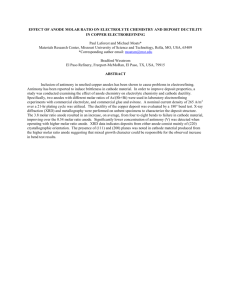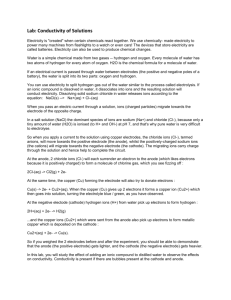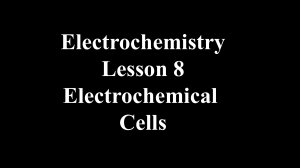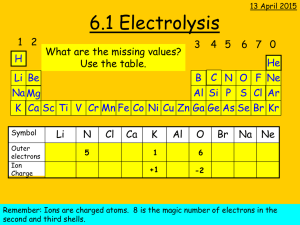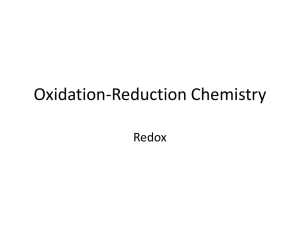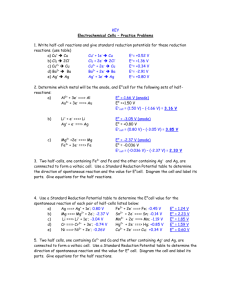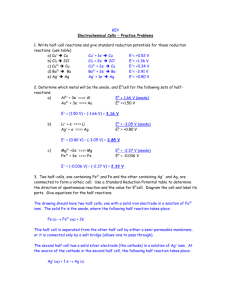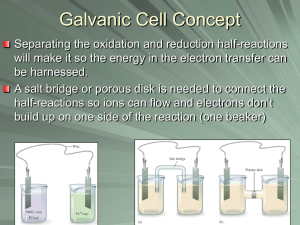electrolysis revision
advertisement
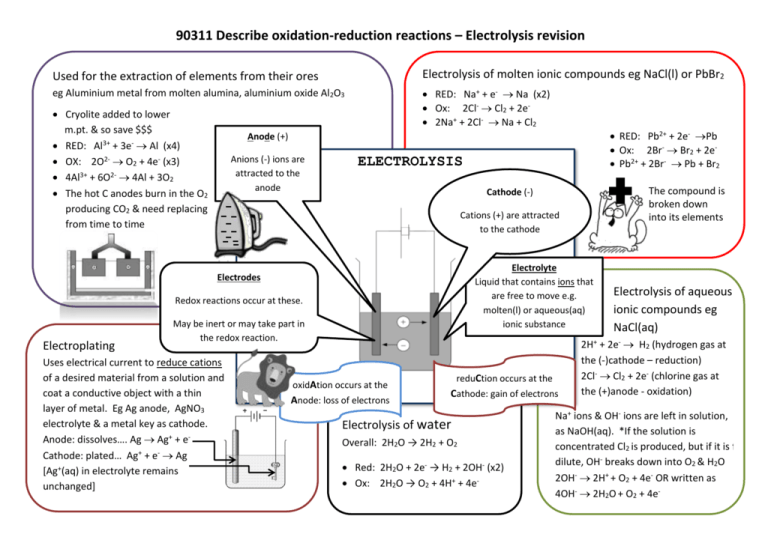
90311 Describe oxidation-reduction reactions – Electrolysis revision Used for the extraction of elements from their ores Electrolysis of molten ionic compounds eg NaCl(l) or PbBr2 eg Aluminium metal from molten alumina, aluminium oxide Al2O3 RED: Na+ + e- Na (x2) Ox: 2Cl- Cl2 + 2e 2Na+ + 2Cl- Na + Cl2 Cryolite added to lower m.pt. & so save $$$ RED: Al3+ + 3e- Al (x4) OX: 2O2- O2 + 4e- (x3) 4Al3+ + 6O2- 4Al + 3O2 The hot C anodes burn in the O2 producing CO2 & need replacing from time to time Anions (-) ions are attracted to the anode ELECTROLYSIS The compound is broken down into its elements Cathode (-) Cations (+) are attracted to the cathode Electrolyte Liquid that contains ions that are free to move e.g. molten(l) or aqueous(aq) ionic substance Electrodes Redox reactions occur at these. Electroplating RED: Pb2+ + 2e- Pb Ox: 2Br- Br2 + 2e Pb2+ + 2Br- Pb + Br2 Anode (+) May be inert or may take part in the redox reaction. Uses electrical current to reduce cations of a desired material from a solution and coat a conductive object with a thin layer of metal. Eg Ag anode, AgNO3 electrolyte & a metal key as cathode. Anode: dissolves…. Ag Ag+ + eCathode: plated… Ag+ + e- Ag [Ag+(aq) in electrolyte remains unchanged] oxidAtion occurs at the Anode: loss of electrons reduCtion occurs at the Cathode: gain of electrons Electrolysis of water Overall: 2H2O → 2H2 + O2 Red: 2H2O + 2e- → H2 + 2OH- (x2) Ox: 2H2O → O2 + 4H+ + 4e- Electrolysis of aqueous ionic compounds eg NaCl(aq) 2H+ + 2e- H2 (hydrogen gas at the (-)cathode – reduction) 2Cl- Cl2 + 2e- (chlorine gas at the (+)anode - oxidation) Na+ ions & OH- ions are left in solution, as NaOH(aq). *If the solution is concentrated Cl2 is produced, but if it is f dilute, OH- breaks down into O2 & H2O 2OH- 2H+ + O2 + 4e- OR written as 4OH- 2H2O + O2 + 4e- PURIFICATION OF COPPER Pure (thin) copper cathode Impure “blister copper” anode Copper sulfate (or chloride) electrolyte, contains Cu2+(aq) – responsible for the blue colour of solution Copper anode dissolves as it is oxidised – the impurities fall in pile below anode as “anode sludge” Anode = oxidation: Cu(s) Cu2+(aq) + 2eCathode = reduction: Cu2+(aq) + 2e- Cu(s) ; copper cathode increases in size as it becomes plate/coated with pure copper Overall equation Cu(s) + Cu2+(aq) Cu2+(aq) + Cu(s) The rate at which the copper ions enter the electrolyte from the anode is the same as the rate at which the copper ions leave the electrolyte at the cathode. The concentration of the Cu2+(aq) therefore remains virtually unchanged so the blue colour of solution remains unchanged. Sludge may contains valuable metals such as silver or gold and is recovered MY EXTRA NOTES



